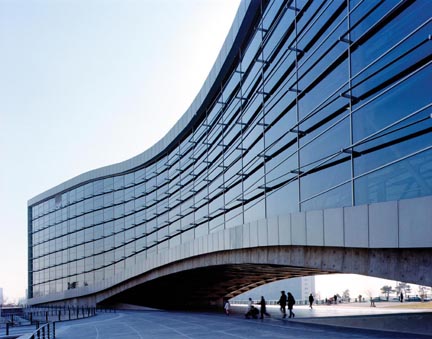
Mellat Park Cineplex by Fluid Motion Architects, Iran
by Wiiliam O. Beeman, Chair of Anthropology, University of Minnesota
Dear Friends
My musings seem to have been of interest to a number of you, so I hope you will indulge me with another postcard. I’ll be here until Sunday
Two other Americans showed up for our conference, entitled “The First International Conference on Human Rights and Cultures: Cultures in Support of Humanity.” It is being held at the Ministry of Foreign Affairs and heavy in attendance are the students from the Foreign Policy School run by the Ministry. Some G2K members may find the subject of the conference “ironic,” but in fact the organizers, the Non Aligned Movement Center for Human Rights and Cultural Diversity, has assembled quite a large and stellar international group of scholars, NGO officers, Peace Movement functionaries and government officials for this.
The 64 presentations have been on a high level, and would meet a significant academic standard anywhere.Some titles:
“Protection of Cultural Property in Armed Conflicts”
“Constructing the Other”
“The Role of Cultural Diversity in Promoting a Culture of Peace”
“Establishing a Normative Framework for Evaluating Diverse Cases of Transitional Justice”Â
The graduate students in international relations are especially impressive. They all have impeccable English, are extremely charming, and are working on serious dissertation topics, such as: “Iran’s Developing Relations with Egypt 2000-2011,” “International Economics in non-petroleum sector in the Gulf Region,” “Iran’s prospects in West Africa” and many more. A group of them at dinner surprised me: “Do you speak Spanish?” Well I do, and so do they–quite impressively! They are all learning Spanish and plan trips to Latin America in the Near Future–even the young man posted as political officer in Sweden.
The young women graduate students have been formidable. Several are giving papers. They make up more than half of the student body. They ask great questions, don’t back down and have facts and figures at the fingertips. Forgive me for noticing sartorial details, but although they are dressed in impeccable hejab, every one of them has something that makes her dress stand out. It seems the fashion is now to turn the naghma’eh into a flattering accessory. There is the naghma’eh with a kind of rhinestone band at the forehead, one with little extensions in the front that can be wrapped in a clever loose bow, one with discreet embroidery around the edge. The women pair long skirts and jackets with front panels in white or pastel colors. They are in effect wearing the equivalent of the skirted suit. It is very smart and very professional while being distinctive.
I am sure there is a great deal of unhappiness in Tehran with the most ordinary meat at $22 a kilo and gasoline at $4 a liter, but this privileged crowd was a very happy bunch. It is always dangerous to conclude things from a few casual encounters, but I was surprised to have a cab driver tell me that gas was “still cheaper than Europe” and a shop-keeper tell me that red meat was too expensive, but there was always chicken, and vegetables were healthier anyway. “You don’t have to put a lot of meat into a khoresht.”
Several people asked me about the Wall Street movement. Their sophistication was notable. One young guy said, “it seems to me that they aren’t accomplishing much unless they can get some law passed.” Many could cite chapter and verse on the bank bailouts, the mortgage crisis and the unequal distribution of income (and taxes)–just proving what I always think coming home, and that is that Iranians know much more about America than Americans do about Iran.
In general everyone I talk to claims that their greatest concern is the economy. They are dismayed at the UK and EU cutting off dealings with the Central and other banks. “It doesn’t hurt the leaders in Tehran or the Guard,” said one, “It hurts ordinary people. We don’t understand why the Europeans and Americans want to do this to us.” So much for the fantasy that if life is made miserable enough, the people will rise up and overthrow their government.
And life is far from miserable, at least in North Tehran. Typical urban landscapes: A giant crystalline cineplex looks down on a huge shopping mall with every possible worldly good readily available. A six lane expressway winds through a gigantic landscaped urban park. The streets are jammed with young people strolling, sitting in cafes and just riding around in their cars.
The delegates to the conference are surprised–especially those who have never been here. “I thought Iran was some dark place with total police control,” said one man from India. “But it isn’t! I haven’t even seen a policeman.” A Vietnamese delegate said: “I thought I was going to be robbed, but my friends here tell me they are completely safe.” Clearly the negative press on Iran has done its job well.
Politics: One ministry official asks me point blank: “Is AIPAC really writing American laws?” Another says: “I guess we shouldn’t hope for closer relations with the U.S. now that the Republicans have Obama trapped.” A third: “Look at all the Chinese and Russians everywhere here. Do you think that is an accident?”
Informal poll: Many people think that Mr. Qalibaf has a good shot at the presidency in 2013. “He’s good looking, speaks well and he has succeeded in several administrative posts.” Some find Mr. Masha’ie intriguing but feel he has been damaged too much by bad press to be viable. People wink and hint at the idea of a revival of the Green Movement. It is clearly a dangerous topic, but it is still on peoples’Â minds.
I certainly urge anyone with an interest to come to Iran. Despite ideological or political misgivings one might have, these discussions are vital and important. Without ideas and human contact nothing will ever change.